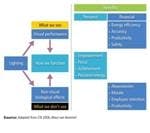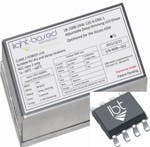This article was published in the June 2012 issue of LEDs Magazine.
View the Table of Contents and download the PDF file of the complete June 2012 issue, or view the E-zine version in your browser.
+++++
The lighting industry will be the next technology segment revolutionized by programmable digital systems and software controls. Purpose-designed semiconductors with robust operating systems and programmable power electronics will unleash the capabilities, many of them unimagined, that lay waiting in the coming revolution within the lighting industry. In the future programmable lighting will have a broad impact ranging from a boost in worker productivity to enhanced happiness and health.
We live in a time when change is the only constant. Technology unlocks new possibilities on a daily basis, and the pace of change is only accelerating. We expect everything we touch to be just the way we want it, and we all want it differently! In the “I” world in which we live today, industry after industry has already, or will soon need to come to terms with this new market dynamic. The convergence and synthesis of multiple new technologies shift market and product developments from evolutionary to revolutionary. History tells us that only those who can quickly and successfully adapt to change survive these shifts. The lighting industry is next.
Indeed the unfolding commercial deployment of LEDs into general lighting applications is the beginning of massive changes for the global lighting industry. On the surface, we might think that all we’re doing is deploying a new, energy-efficient light source into our existing infrastructure. And at the leading edge of market adoption for LED-based solid-state lighting (SSL), this simplistic view is somewhat true. Will the new LED replacement bulbs fit existing sockets? Will they work properly with already installed dimmers? Can they integrate with energy-saving, centralized control systems? These are all good questions during the early days of market adoption. What however, are the real mid to long term implications for the lighting industry resulting from the arrival of SSL? Are there relevant examples we can learn from?
Parallels from other industries
There are many examples of industries that have seen their ongoing technical evolution experience a revolutionary pivot brought on by the dominant emergence of digital control and software-enabled functionality. The recorded music industry went from vinyl to compact discs fairly smoothly but was completely re-shaped by compressed digital music and the onslaught of platforms such as iTunes. The photography industry was a stable marketplace for a handful of well-established incumbents until digital cameras and software-enabled, image-capture and editing capabilities arrived. Those two industries that were tightly held by a few are widely owned and personalized by many. This happened when the value shifted from hardware to software.
We already see advancements in the industry in terms of the methods and granularity of control for lighting. Methods of control include user interfaces for manual adjustments and the intelligence necessary for automatic adjustments in response to external factors such as daylight availability, occupancy, or time of day.
Granularity of control consists of two distinct elements: the physical axis and the dynamic axis. The physical axis is the number of fixtures, and hence loosely the size of a space, that is controlled by a single control channel. The dynamic axis represents what characteristics of the light can be controlled within the physical space.
Intuitive interfaces
User-friendly, accessible interfaces brought on the explosive growth of PCs and then smart phones. We anticipate that similar capabilities will unlock new functionality in lighting. For office workers, control may come via a desktop computer, or for educational institutions through a handheld mobile device for the teacher. Technology will not only allow manual adjustments, but automatic ones to deliver desired lighting outcomes in the best possible manner. Much like your computer hibernates to save energy if not used for a period, so too will lights turn off without occupants. Lights will dim when the light coming through the window becomes more intense, and even adapt spectral content to suit individual needs and time of day.
With the physical axis, you will individually control each element in a lit environment, from an entire building down to a personal workspace. One example of the benefit of a more granular physical scale of control would be in a classroom where the lights nearer to a window would dim more in response to bright sunshine streaming in the window, as the desks they illuminate receive more natural daylight than those farther from the window.
On the dynamic axis, the progression will move towards a wider range of capabilities. The coarsest dynamic control is simply on or off, followed by dimming of light levels. More sophisticated dynamics include adjustments to Correlated Color Temperature (CCT) which can eventually lead to full control of the spectral content. Such granular dynamic control will enable fixtures to replicate natural light, address user preferences, and potentially offer other tangible benefits.
We will see this combination of improved methods and granularity of control deliver added value across all lighting applications, and result in the mass-customization of lighting outputs, or what we call the personalization of light. Just as your mobile phone automatically detects available networks, your lights, when you enter a room at any specific time of day will automatically adjust to deliver your preselected settings of dimming and color temperature.
Advantages of personalized light
The personalization of light will bring benefits to all the stakeholders in a lit environment. Recent research supports an updated model for our view of lighting, its impact and potential benefits, which can be seen in Fig 1. This framework underpins the value that we see coming from the personalization of light. The US Department of Energy (DOE) has projected that employers will see financial benefits from higher employee productivity. The Lighting Research Center at Rensselaer Polytechnic Institute expects improved learning from students. The Maastricht University Medical Center and Philips Lighting have published research that indicates medical patients rest better in a lighting environment that mimics the natural day-night outdoor cycle stimulating health and wellbeing.
The visual impact of light includes the amount and intensity of light delivered and its color temperature. It comes as no surprise that task performance suffers if an area is under lit but the quality of work and the user satisfaction is also affected by the appropriateness of the color temperature of the light in the space. As a result, current lighting control strategies focus on delivering energy efficiency while maintaining sufficient light to maximize accuracy, productivity and safety. The intensity of light delivered impacts the most widely understood aspects of the user experience, but is not the only aspect.
The non-visual impacts of light in response to flicker have long been known. These impacts were first noted with fluorescent lights, as people reported headaches, eye-strain and other ill effects under magnetic ballasts, even among individuals who were not able to consciously detect flicker.
Dynamic lighting research
Recent studies, however, have shown that people significantly respond to color temperature, spectral content and modulation of light. The concept of dynamic lighting is based on the natural light outdoors under which we evolved. Just as the sun changes color temperature throughout the day, seasons and weather, artificial light can be adapted to mimic nature. Dynamic lighting influences human performance metrics through setting our biological clock, and providing non-visual cues that stimulate our brains. The Fraunhofer Institute for Industrial Engineering (Fig. 3), for instance, has documented positive qualitative reports from subjects in dynamic lighting tests.
Adjusting the spectral content of light, as well as its brightness, throughout the day, and thereby mimicking the natural environment, will set internal cycles that support our natural rhythms. The biological clock, or circadian rhythm, is affected more by the presence and absence of blue light than any other portion of the light spectrum. During the active parts of the day, blue light, around 460 nm, should be present in larger quantities to support hormone production for alertness and activity. If blue light is then removed later in the day it will stimulate a reduction in the hormone cortisol that is correlated with wakefulness, and begin the production of melatonin, associated and required for proper sleep. Proper biological rhythms are accepted to have positive effects on cognition, well-being and sleep.
The walls and ceiling of our indoor environments must be able to mimic the outdoor environment in delivery of light as well as spectral content. The center of the eye is used for what you consciously focus on, which has driven the traditional focus of lux on a work surface. The receptors that influence your circadian rhythm, however, are more equally distributed throughout the eye. The delivery of light across a wider portion of an observer’s vision will impact fixture design and placement.
Human performance metrics that measure learning, safety and retention capacity are becoming scientifically proven and well understood. These studies show that dynamic lighting will have positive effects on healing and disease avoidance. Dynamic lighting translates into better educational outcomes, more productive workers and improved health, safety and quality of life.
Delivering personalized light
Though some forward looking devices exist on the market today, they are predominantly indicators of the changes contemplated above. They are not yet fully integrated or personalized, and there is no accepted standard operating system. To date, these early devices make up a very small portion of the industry’s sales and their adoption issues are still being resolved while sustainable solutions are being identified. As early smart phones did not seamlessly integrate all the functionality possible, we expect personalization features will be rolled out in stages – and sooner than many might think.
As recently as 2009, the DOE was projecting 140 lm/W efficacy by 2015 for warm white LEDs. We have achieved this already. The SSL industry is accelerating beyond expectations and is now poised to explode, which will naturally pull forward performance and cost target timelines. The communication and control capabilities necessary for the personalization of light exist today, but in fragmented, costly systems. Time will tell when various features and functions will become widely adopted, but if history repeats itself, we will see the exciting iteration of user flexibility and customization begin in parallel with expanded programmability. Once this personalization of light begins, and it becomes more commonly understood, it will accelerate.
What is important to note is that, whether it be the most basic early adoption requirements or the most forward looking personalization, there are critical common elements that we have seen before. Purpose-designed semiconductors with robust operating systems and programmable power electronics will unleash the capabilities that lay waiting in the coming revolution within the lighting industry.








